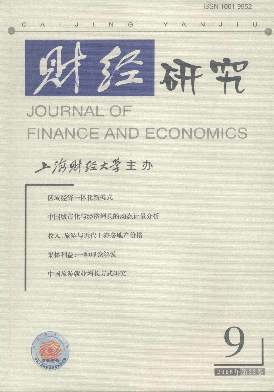“上证”A股市场情绪的关键影响因素
财经研究 2006 年 第 32 卷第 09 期, 页码:52 - 61
摘要
参考文献
摘要
文章从投资者认知偏误视角,研究提出了“上证”A股市场情绪的四维量表,系统整合了18个关键影响因素,形成中国证券市场情绪的关键影响因素概念模型。采用“上证”A股市场中152家企业的调研数据,进行验证性因子分析和拟合优度检验。结果表明,12个理论因素按预期模式加载,形成了认知偏误、有限套利、交互传染和本土特性等四个维度,对认识中国证券投资者的决策行为具有一定指导意义。
[1]陈彦斌.情绪波动和资产价格波动[J].经济研究,2005,(3):36~45.
[2]刘煜辉,熊鹏.资产流动性、投资者情绪与中国封闭式基金之谜[J].管理世界,2004,(3):48~57.
[3]王美今,孙建军.中国股市收益、收益波动与投资者情绪[J].经济研究,2004,(10):75~83.
[4]Athanasoulis S G.Asset pricing from primitives:Closed form solutions to asset prices,consumption,and portfolio demands[J].Journal of Economic Dynamics and Control,2005,29(3):423~447.
[5]Avery C,Chevalier J.Identifying investor sentiment from price paths:The case offootball betting[J].Journal of Business,1999,72(4):493~521.
[6]Barberis N,Shleifer A,Vishny R.A model of investor sentiment[J].Journal of Fi-nancial Economics,1998,49(3):307~343.
[7]Basak S.Asset pricing with heterogeneous beliefs[J].Journal of Banking&Finance,2005,29(11):2849~2881.
[8]Bekaert G,Harvey C R.Emerging markets finance[J].Journal of Empirical Finance,2003,10(1):3~56.
[9]Black F.Noise[J].Journal of Finance,1986,41(3):529~543.
[10]Brown G W,Cliff M T.Investor sentiment and the near-term stock market[J].Journal of Empirical Finance,2004,11(1):1~27.
[11]Campbell J,Kyle A.Smart money,noise trading and stock price behaviour[J].Re-view of Economic Studies,1993,60(1):1~34.
[12]Chan W S,Frankel R,Kothari S P.Testing behavioral finance theories using trendsand consistency in financial performance[J].Journal of Accounting and Economics,2004,38(1):3~50.
[13]Daniel K,Hirshleifer D,Subrahmanyam A.Investor psychology and security marketunder and overreactions[J].Journal of Finance,1998,53(6):1839~1886.
[14]De Bondt W,Palm F,Wolff C.Introduction to the special issue on behavioral finance[J].Journal of Empirical Finance,2004,11(4):423~427.
[15]De Long J B,Shleifer A,Summers L H,Waldmann R J.Noise trader risk in finan-cial markets[J].Journal of Political Economy,1990,98(4):703~738.
[16]Ewing B T.The transmission of shocks among S&P indexes[J].Applied FinancialEconomics,2002,12(4):285~290.
[17]Frankfurter G M,McGoun E G.Anomalies in finance:What are they and what arethey good for?[J].International Review of Financial Analysis,2001,10(4):407~429.
[18]Frankfurter G M,McGoun E G.Resistance is futile:The assimilation of behavioralfinance[J].Journal of Economic Behavior&Organization,2002,48(4):375~389.
[19]Girardin E,Liu Z Y.Bank credit and seasonal anomalies in China’s stock markets[J].China Economic Review,2005,16(4):465~483.
[20]Goldbaum D.Market efficiency and learning in an endogenously unstable environment[J].Journal of Economic Dynamics and Control,2005,29(5):953~978.
[21]Grossman S,Stiglitz J.On the impossibility of informationally efficient markets[J].American Economic Review,1980,70(3):393~408.
[22]Hirshleifer D.Investor psychology and asset pricing[J].Journal of Finance,2001,56(4):1533~1597.
[23]Hogan S,Jarrow R,Teo M,Warachka M.Testing market efficiency using statisticalarbitrage with applications to momentum and value strategies[J].Journal of FinancialEconomics,2004,73(3):525~565.
[24]Jegadeesh N,Titman S.Profitability of momentum strategies:An evaluation of alter-native explanations[J].Journal of Finance,2001,56(2):699~720.
[25]Kahneman D,Tversky A.Prospect theory:An analysis of decision under risk[J].Econometrica,1979,47(2):263~291.
[26]Kang J,Liu M H,Ni S.Contrarian and momentum strategies in the China stockmarket:1993~2000[J].Pacific-Basin Finance Journal,2002,10(3):243~265.
[27]Kapopoulos P,Siokis F.Stock market crashes and dynamics of aftershocks[J].Eco-nomics Letters,2005,89(1):48~54.
[28]Lee W Y,Jiang C X,Indro D C.Stock market volatility,excess returns,and the roleof investor sentiment[J].Journal of Banking and Finance,2002,26(12):2277~2299.
[29]Lee S,Song X.Maximum likelihood estimation and model comparison of nonlinearSEM with continuous and polytomous variables[J].Computational Statistics&DataAnalysis,2003,44(1):125~142.
[30]McQuitty S.Statistical power and structural equation models in business research[J].Journal of Business Research,2004,57(2):175~183.
[31]Montrucchio L,Privileggi F.On fragility of bubbles in equilibrium asset pricing mod-els of Lucas-Type[J].Journal of Economic Theory,2001,101(1):158~188.
[32]Morck R,Yeung B,Yu W.The information content of stock markets:Why do emer-ging markets have synchronous stock price movements?[J].Journal of Financial Eco-nomics,2000,58(1):215~260.
[33]Prast H M,De-Vor M P.Investor reactions to news:A cognitive dissonance analysisof the euro-dollar exchange rate[J].European Journal of Political Economy,2005,21(1):115~141.
[34]Shleifer A,Vishny R.The limits of arbitrage[J].Journal of Finance,1997,52(1):35~55.
[35]Wang C Y,Cheng N S.Extreme volumes and expected stock returns:Evidence fromChina’s stock market[J].Pacific-Basin Finance Journal,2004,12(5):577~597.
[36]Wang Z J,Kutan A M,Yang J.Information flows within and across sectors in Chi-nese stock markets[J].The Quarterly Review of Economics and Finance,2005,45(4):767~780.
[37]Zin S E.Are behavioral asset-pricing models structural?[J].Journal of Monetary E-conomics,2002,49(1):215~228.
[2]刘煜辉,熊鹏.资产流动性、投资者情绪与中国封闭式基金之谜[J].管理世界,2004,(3):48~57.
[3]王美今,孙建军.中国股市收益、收益波动与投资者情绪[J].经济研究,2004,(10):75~83.
[4]Athanasoulis S G.Asset pricing from primitives:Closed form solutions to asset prices,consumption,and portfolio demands[J].Journal of Economic Dynamics and Control,2005,29(3):423~447.
[5]Avery C,Chevalier J.Identifying investor sentiment from price paths:The case offootball betting[J].Journal of Business,1999,72(4):493~521.
[6]Barberis N,Shleifer A,Vishny R.A model of investor sentiment[J].Journal of Fi-nancial Economics,1998,49(3):307~343.
[7]Basak S.Asset pricing with heterogeneous beliefs[J].Journal of Banking&Finance,2005,29(11):2849~2881.
[8]Bekaert G,Harvey C R.Emerging markets finance[J].Journal of Empirical Finance,2003,10(1):3~56.
[9]Black F.Noise[J].Journal of Finance,1986,41(3):529~543.
[10]Brown G W,Cliff M T.Investor sentiment and the near-term stock market[J].Journal of Empirical Finance,2004,11(1):1~27.
[11]Campbell J,Kyle A.Smart money,noise trading and stock price behaviour[J].Re-view of Economic Studies,1993,60(1):1~34.
[12]Chan W S,Frankel R,Kothari S P.Testing behavioral finance theories using trendsand consistency in financial performance[J].Journal of Accounting and Economics,2004,38(1):3~50.
[13]Daniel K,Hirshleifer D,Subrahmanyam A.Investor psychology and security marketunder and overreactions[J].Journal of Finance,1998,53(6):1839~1886.
[14]De Bondt W,Palm F,Wolff C.Introduction to the special issue on behavioral finance[J].Journal of Empirical Finance,2004,11(4):423~427.
[15]De Long J B,Shleifer A,Summers L H,Waldmann R J.Noise trader risk in finan-cial markets[J].Journal of Political Economy,1990,98(4):703~738.
[16]Ewing B T.The transmission of shocks among S&P indexes[J].Applied FinancialEconomics,2002,12(4):285~290.
[17]Frankfurter G M,McGoun E G.Anomalies in finance:What are they and what arethey good for?[J].International Review of Financial Analysis,2001,10(4):407~429.
[18]Frankfurter G M,McGoun E G.Resistance is futile:The assimilation of behavioralfinance[J].Journal of Economic Behavior&Organization,2002,48(4):375~389.
[19]Girardin E,Liu Z Y.Bank credit and seasonal anomalies in China’s stock markets[J].China Economic Review,2005,16(4):465~483.
[20]Goldbaum D.Market efficiency and learning in an endogenously unstable environment[J].Journal of Economic Dynamics and Control,2005,29(5):953~978.
[21]Grossman S,Stiglitz J.On the impossibility of informationally efficient markets[J].American Economic Review,1980,70(3):393~408.
[22]Hirshleifer D.Investor psychology and asset pricing[J].Journal of Finance,2001,56(4):1533~1597.
[23]Hogan S,Jarrow R,Teo M,Warachka M.Testing market efficiency using statisticalarbitrage with applications to momentum and value strategies[J].Journal of FinancialEconomics,2004,73(3):525~565.
[24]Jegadeesh N,Titman S.Profitability of momentum strategies:An evaluation of alter-native explanations[J].Journal of Finance,2001,56(2):699~720.
[25]Kahneman D,Tversky A.Prospect theory:An analysis of decision under risk[J].Econometrica,1979,47(2):263~291.
[26]Kang J,Liu M H,Ni S.Contrarian and momentum strategies in the China stockmarket:1993~2000[J].Pacific-Basin Finance Journal,2002,10(3):243~265.
[27]Kapopoulos P,Siokis F.Stock market crashes and dynamics of aftershocks[J].Eco-nomics Letters,2005,89(1):48~54.
[28]Lee W Y,Jiang C X,Indro D C.Stock market volatility,excess returns,and the roleof investor sentiment[J].Journal of Banking and Finance,2002,26(12):2277~2299.
[29]Lee S,Song X.Maximum likelihood estimation and model comparison of nonlinearSEM with continuous and polytomous variables[J].Computational Statistics&DataAnalysis,2003,44(1):125~142.
[30]McQuitty S.Statistical power and structural equation models in business research[J].Journal of Business Research,2004,57(2):175~183.
[31]Montrucchio L,Privileggi F.On fragility of bubbles in equilibrium asset pricing mod-els of Lucas-Type[J].Journal of Economic Theory,2001,101(1):158~188.
[32]Morck R,Yeung B,Yu W.The information content of stock markets:Why do emer-ging markets have synchronous stock price movements?[J].Journal of Financial Eco-nomics,2000,58(1):215~260.
[33]Prast H M,De-Vor M P.Investor reactions to news:A cognitive dissonance analysisof the euro-dollar exchange rate[J].European Journal of Political Economy,2005,21(1):115~141.
[34]Shleifer A,Vishny R.The limits of arbitrage[J].Journal of Finance,1997,52(1):35~55.
[35]Wang C Y,Cheng N S.Extreme volumes and expected stock returns:Evidence fromChina’s stock market[J].Pacific-Basin Finance Journal,2004,12(5):577~597.
[36]Wang Z J,Kutan A M,Yang J.Information flows within and across sectors in Chi-nese stock markets[J].The Quarterly Review of Economics and Finance,2005,45(4):767~780.
[37]Zin S E.Are behavioral asset-pricing models structural?[J].Journal of Monetary E-conomics,2002,49(1):215~228.
引用本文
姜继娇, 杨乃定, 王良, 等. “上证”A股市场情绪的关键影响因素[J]. 财经研究, 2006, 32(9): 52–61.
导出参考文献,格式为:
上一篇:所有制起源及其变迁致因新探





 7215
7215  10390
10390

